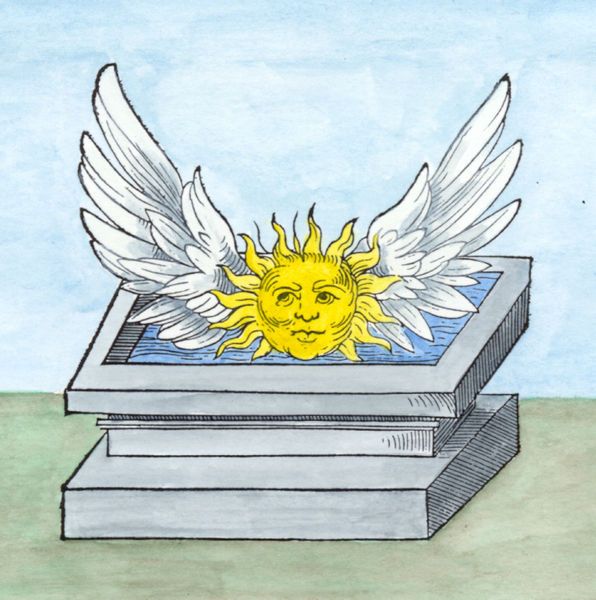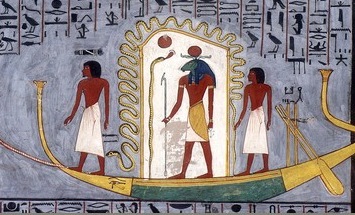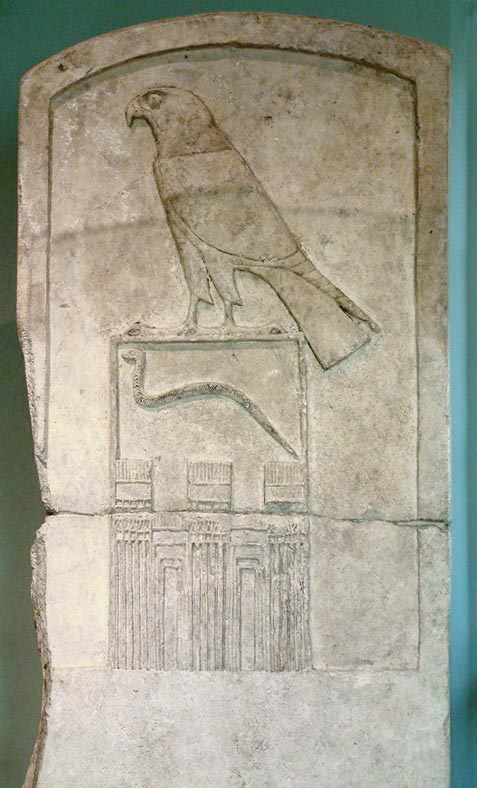|
Pyramidion Of Amenemhat III
The pyramidion of Amenemhat III is the capstone that once crowned the Black Pyramid at Dashur, Egypt. Crafted around 1850 BC, towards the end of the 12th Dynasty during the Middle Kingdom, it remained mostly intact and is now located in the Egyptian Museum in Cairo. Rediscovery In the year 1900, the then director of the Department of Antiquities Gaston Maspero had Dashur inspected, after the guards at the Saqqara necropolis were attacked by robbers. On the east side of the pyramid of Amenemhat, a grey block was found sticking out of the sand, which, upon closer inspection, was decorated with beautiful inscriptions. After excavation, the pyramidion was transported to the Egyptian Museum in Cairo. Description The pyramidion, carved out of single piece of basalt (often called black granite), is mostly intact apart from a broken corner. With a height of and base length , it weighs around . The bottom edges are undercut to keep the block in position atop the pyramid. Inscr ... [...More Info...] [...Related Items...] OR: [Wikipedia] [Google] [Baidu] |
Basalt
Basalt (; ) is an aphanitic (fine-grained) extrusive igneous rock formed from the rapid cooling of low-viscosity lava rich in magnesium and iron (mafic lava) exposed at or very near the surface of a rocky planet or moon. More than 90% of all volcanic rock on Earth is basalt. Rapid-cooling, fine-grained basalt is chemically equivalent to slow-cooling, coarse-grained gabbro. The eruption of basalt lava is observed by geologists at about 20 volcanoes per year. Basalt is also an important rock type on other planetary bodies in the Solar System. For example, the bulk of the plains of Venus, which cover ~80% of the surface, are basaltic; the lunar maria are plains of flood-basaltic lava flows; and basalt is a common rock on the surface of Mars. Molten basalt lava has a low viscosity due to its relatively low silica content (between 45% and 52%), resulting in rapidly moving lava flows that can spread over great areas before cooling and solidifying. Flood basalts are thick sequence ... [...More Info...] [...Related Items...] OR: [Wikipedia] [Google] [Baidu] |
Winged Sun
The winged sun is a solar symbol associated with divinity, royalty, and power in the Ancient Near East (Egypt, Mesopotamia, Anatolia, and Persia). Ancient Egypt In ancient Egypt, the symbol is attested from the Old Kingdom (Sneferu, 26th century BC ), often flanked on either side with a uraeus. Behdety In early Egyptian religion, the symbol Behdety represented Horus of Edfu, later identified with Ra-Horakhty. It is sometimes depicted on the neck of Apis, the bull of Ptah. As time passed (according to interpretation) all of the subordinated gods of Egypt were considered to be aspects of the sun god, including Khepri. The name "Behdety" means the inhabitant of Behdet. He was the ''sky god'' of the region called ''Behdet'' in the Nile basin. His image was first found in the inscription on a comb's body, as a winged solar panel. The period of the comb is about 3000 BC. Such winged solar panels were later found in the funeral picture of Pharaoh Sahure of the fifth dynasty. Be ... [...More Info...] [...Related Items...] OR: [Wikipedia] [Google] [Baidu] |
Annales Du Service Des Antiquités De L'Égypte
Annals are a concise form of historical writing which record events chronologically, year by year. The equivalent word in Latin and French is ''annales'', which is used untranslated in English in various contexts. List of works with titles containing the word "Annales" * ''Annales'' (Ennius), an epic poem by Quintus Ennius covering Roman history from the fall of Troy down to the censorship of Cato the Elder * Annals (Tacitus) ''Ab excessu divi Augusti'' "Following the death of the divine Augustus" * Annales Alamannici, ed. W. Lendi, Untersuchungen zur frühalemannischen Annalistik. Die Murbacher Annalen, mit Edition (Freiburg, 1971) * Annales Bertiniani, eds. F. , J. Vielliard, S. Clemencet and L. Levillain, Annales de Saint-Bertin (Paris, 1964) * Annales du Muséum national d'histoire naturelle, Paris, France. Published 1802 to 1813, then became the Mémoires then the Nouvelles Annales * Annales Fuldenses, ed. F. Kurze, ''Monumenta Germaniae Historica'' SRG (Hanover, 1891) * ... [...More Info...] [...Related Items...] OR: [Wikipedia] [Google] [Baidu] |
Akhenaten
Akhenaten (pronounced ), also spelled Echnaton, Akhenaton, ( egy, ꜣḫ-n-jtn ''ʾŪḫə-nə-yātəy'', , meaning "Effective for the Aten"), was an ancient Egyptian pharaoh reigning or 1351–1334 BC, the tenth ruler of the Eighteenth Dynasty. Before the fifth year of his reign, he was known as Amenhotep IV ( egy, jmn-ḥtp, links=no, meaning " Amun is satisfied", Hellenized as ''Amenophis IV''). As a pharaoh, Akhenaten is noted for abandoning Egypt's traditional polytheism and introducing Atenism, or worship centered around Aten. The views of Egyptologists differ as to whether the religious policy was absolutely monotheistic, or whether it was monolatry, syncretistic, or henotheistic. This culture shift away from traditional religion was reversed after his death. Akhenaten's monuments were dismantled and hidden, his statues were destroyed, and his name excluded from lists of rulers compiled by later pharaohs. Traditional religious practice was gradually resto ... [...More Info...] [...Related Items...] OR: [Wikipedia] [Google] [Baidu] |
Cartouche
In Egyptian hieroglyphs, a cartouche is an oval with a line at one end tangent to it, indicating that the text enclosed is a royal name. The first examples of the cartouche are associated with pharaohs at the end of the Third Dynasty, but the feature did not come into common use until the beginning of the Fourth Dynasty under Pharaoh Sneferu. While the cartouche is usually vertical with a horizontal line, if it makes the name fit better it can be horizontal, with a vertical line at the end (in the direction of reading). The ancient Egyptian word for cartouche was , and the cartouche was essentially an expanded shen ring. Demotic script reduced the cartouche to a pair of brackets and a vertical line. Of the five royal titularies it was the ''prenomen'' (the throne name), and the "Son of Ra" titulary (the so-called '' nomen'' name given at birth), which were enclosed by a cartouche. At times amulets took the form of a cartouche displaying the name of a king and placed in to ... [...More Info...] [...Related Items...] OR: [Wikipedia] [Google] [Baidu] |
Amun
Amun (; also ''Amon'', ''Ammon'', ''Amen''; egy, jmn, reconstructed as ( Old Egyptian and early Middle Egyptian) → (later Middle Egyptian) → ( Late Egyptian), cop, Ⲁⲙⲟⲩⲛ, Amoun) romanized: ʾmn) was a major ancient Egyptian deity who appears as a member of the Hermopolitan Ogdoad. Amun was attested from the Old Kingdom together with his wife Amunet. With the 11th Dynasty ( 21st century BC), Amun rose to the position of patron deity of Thebes by replacing Montu. After the rebellion of Thebes against the Hyksos and with the rule of Ahmose I (16th century BC), Amun acquired national importance, expressed in his fusion with the Sun god, Ra, as Amun-Ra (alternatively spelled Amon-Ra or Amun-Re). Amun-Ra retained chief importance in the Egyptian pantheon throughout the New Kingdom (with the exception of the " Atenist heresy" under Akhenaten). Amun-Ra in this period (16th to 11th centuries BC) held the position of transcendental, self-created creator d ... [...More Info...] [...Related Items...] OR: [Wikipedia] [Google] [Baidu] |
Duat
The Duat ( egy, dwꜣt, Egyptological pronunciation "do-aht", cop, ⲧⲏ, also appearing as ''Tuat'', ''Tuaut'' or ''Akert'', ''Amenthes'', ''Amenti'', or ''Neter-khertet'') is the realm of the dead in ancient Egyptian mythology. It has been represented in hieroglyphs as a star-in-circle: 𓇽. The god Osiris was believed to be the lord of the underworld. He was the first mummy as depicted in the Osiris myth and he personified rebirth and life after death. The underworld was also the residence of various other gods along with Osiris. The geography of the ''Duat'' is similar in outline to the world the Egyptians knew: There are realistic features like rivers, islands, fields, lakes, mounds and caverns, but there were also fantastic lakes of fire, walls of iron, and trees of turquoise. In the ''Book of Two Ways'' (a Coffin Text) there is even a map-like image of the ''Duat''. Resident souls, gods, and demons The ''Duat'' was also a residence for various gods, including Osi ... [...More Info...] [...Related Items...] OR: [Wikipedia] [Google] [Baidu] |
Orion (constellation)
Orion is a prominent constellation located on the celestial equator and visible throughout the world. It is one of the most conspicuous and recognizable constellations in the night sky. It is named after Orion, a hunter in Greek mythology. Its brightest stars are the blue-white Rigel (Beta Orionis) and the red Betelgeuse (Alpha Orionis). Characteristics Orion is bordered by Taurus to the northwest, Eridanus to the southwest, Lepus to the south, Monoceros to the east, and Gemini to the northeast. Covering 594 square degrees, Orion ranks twenty-sixth of the 88 constellations in size. The constellation boundaries, as set by Belgian astronomer Eugène Delporte in 1930, are defined by a polygon of 26 sides. In the equatorial coordinate system, the right ascension coordinates of these borders lie between and , while the declination coordinates are between and . The constellation's three-letter abbreviation, as adopted by the International Astronomical Union in 1922, is "Ori ... [...More Info...] [...Related Items...] OR: [Wikipedia] [Google] [Baidu] |
Ancient Egyptian Conception Of The Soul
The ancient Egyptians believed that a soul ( kꜣ and bꜣ; Egypt. pron. ka/ba) was made up of many parts. In addition to these components of the soul, there was the human body (called the ''ḥꜥ'', occasionally a plural '' ḥꜥw'', meaning approximately "sum of bodily parts"). According to ancient Egyptian creation myths, the god Atum created the world out of chaos, utilizing his own magic ( ḥkꜣ). Because the earth was created with magic, Egyptians believed that the world was imbued with magic and so was every living thing upon it. When humans were created, that magic took the form of the soul, an eternal force which resided in and with every human. The concept of the soul and the parts which encompass it has varied from the Old Kingdom to the New Kingdom, at times changing from one dynasty to another, from five parts to more. Most ancient Egyptian funerary texts reference numerous parts of the soul: Collectively, these spirits of a dead person were called the ... [...More Info...] [...Related Items...] OR: [Wikipedia] [Google] [Baidu] |
Ancient Egyptian Royal Titulary
The royal titulary or royal protocol is the standard naming convention taken by the pharaohs of ancient Egypt. It symbolised worldly power and holy might, also acting as a sort of mission statement for the duration of a monarch's reign (although sometimes it even changed during the reign). The full titulary, consisting of five names, did not come into standard usage until the Middle Kingdom but remained in use as late as the Roman Empire. Origins In order that the pharaoh, who held divine office, could be linked to the people and the gods, special epithets were created for them at their accession to the throne. These titles also served to demonstrate one's qualities and link them to the terrestrial realm. The five names were developed over the centuries beginning with the Horus name. This name identified the figure as a representative of the god Horus. The Nebty name was the second part of the royal titular of Upper and Lower Egypt. This name placed the king under the protect ... [...More Info...] [...Related Items...] OR: [Wikipedia] [Google] [Baidu] |
Nefer
The Egyptian hieroglyph for "perfect, complete" (with the extended meanings of "good, pleasant, well, beautiful") in Gardiner's sign list is numbered F35; its phonetic value is ', with a reconstructed pronunciation of and a conventional Egyptological vocalization of '. Hieroglyphs and symbolism The triliteral Egyptian hieroglyph F35 ('nfr') has sometimes been explained as a representation of a lute; however, Egyptologists today no longer consider this hypothesis likely. Rather than a lute, the hieroglyph is actually a representation of the heart and trachea. It originally may have been the esophagus and heart. The striations of the windpipe only appear in the hieroglyph following the Old Kingdom of Egypt. The lower part of the sign has always clearly been the heart, for the markings clearly follow the form of a sheep's heart. Use The term ' has been incorporated into many names in Ancient Egypt. Examples include Nefertiti, Nefertari, and Neferhotep. Some scholars suggest ... [...More Info...] [...Related Items...] OR: [Wikipedia] [Google] [Baidu] |


_(2865505031).jpg)



